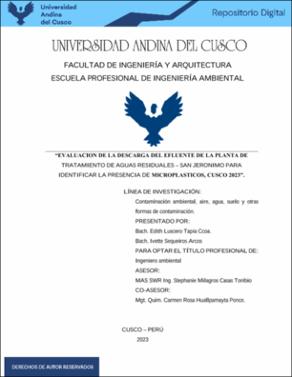| dc.contributor.advisor | Casas Toribio, Stephanie Milagros | |
| dc.contributor.advisor | Huallpamayta Ponce, Carmen Rosa | |
| dc.contributor.author | Tapia Ccoa, Edith Luscero | |
| dc.contributor.author | Sequeiros Arcos, Ivette | |
| dc.date.accessioned | 2024-01-22T20:17:06Z | |
| dc.date.available | 2024-01-22T20:17:06Z | |
| dc.date.issued | 2023-12-07 | |
| dc.identifier.uri | https://hdl.handle.net/20.500.12557/6030 | |
| dc.description.abstract | Los microplásticos son partículas minúsculas presentes en todos los ecosistemas, en especial
el agua, su presencia está relacionada con el inadecuado manejo de residuos plásticos
generados por el consumo masivo de diversas actividades productivas. Las principales
fuentes de contaminación por microplásticos son los residuos presentes en los ríos y aguas
superficiales, al igual que las aguas residuales provenientes de actividades industriales y
domésticas. A nivel nacional se han realizado escasas investigaciones sobre la identificación
de microplásticos en sedimentos y hasta la fecha ninguna investigación en Plantas de
tratamiento de aguas residuales. Por esta razón, la presente investigación se enfoca en evaluar
la descarga del efluente de la Planta de tratamiento de aguas residuales - San Jerónimo, con
el objetivo de identificar la presencia de microplásticos. Así mismo, se aplicó una
metodología de nivel descriptivo, enfoque cuantitativo y diseño de investigación no
experimental, donde se tomó muestras simples en 3 puntos de muestreo con 7 réplicas. Del
total de muestras analizadas, los resultados identifican 6208 und/l de microplásticos. Según
su morfología se identificaron de mayor cantidad de tipo fragmento (37%), en cuanto al color
predominó el translúcido (54.36%) y en menor cantidad el color amarillo (1.78%). En cuanto
al tamaño por forma, el tipo fibra presenta mayor tamaño con un promedio de 1023.22 μm,
y el tipo fragmento presenta el menor tamaño 111.72 μm. Se identificaron 5 tipos de
polímeros correspondientes a; Polietileno (PE) 35%, Polipropileno (PP) 32%,
Poliamida/Nylon (PA) 19%, polietileno de baja densidad (LDPE) 11% y Policloruro de vinilo
(PVC) 6%. Los datos recopilados, establecen una línea base que resulta valiosa para
comprender el contexto actual de los microplásticos presentes en la descarga del efluente de
la Planta de tratamiento de aguas residuales - San Jerónimo. | es_PE |
| dc.description.abstract | Microplastics are tiny particles present in the environment ecosystems, especially water, their
presence is related to the inadequate management of plastic waste generated by the massive
consumption of various productive activities. The main sources of microplastic pollution are
waste present in rivers and surface waters, as well as wastewater from industrial and domestic
activities. At the national level, few studies have been carried out on the identification of
microplastics in sediments and to date, none in Wastewater Treatment Plants. For this reason,
this research considers the discharge of the effluent from the San Jerónimo WWTP as a study
unit, with the objective of identifying the presence of microplastics. Likewise, a descriptive
level, quantitative methodology with a non-experimental research design was applied, where
simple samples were taken at 3 sampling points with 7 replications. Of the total samples
analyzed, the results identify 6208 und/L of microplastics. According to their morphology, a
greater quantity of fragment type was identified (37%), in terms of color, translucent
predominated (54.36%) and in a lesser quantity, yellow (1.78%). Regarding size by shape,
the fiber type has the largest size with an average of (1023.22 μm), and the fragment type
with (111.72 μm) represents the smallest size. 5 types of polymers were identified
corresponding to; Polyethylene (PE) 35%, Polypropylene (PP) 32%, Polyamide/Nylon (PA)
19%, low density polyethylene (LDPE) 11% and Polyvinyl chloride (PVC) 6%. The data
collected establishes a baseline that is valuable to understand the current context of
microplastics in treated wastewater from the San Jerónimo WWTP. | en_US |
| dc.format | application/pdf | es_PE |
| dc.language.iso | spa | es_PE |
| dc.publisher | Universidad Andina del Cusco | es_PE |
| dc.rights | info:eu-repo/semantics/openAccess | es_PE |
| dc.rights.uri | https://creativecommons.org/licenses/by-nc-nd/4.0/ | es_PE |
| dc.subject | Microplásticos | es_PE |
| dc.subject | Polímeros | es_PE |
| dc.subject | Morfología | es_PE |
| dc.subject | Espectroscopio | es_PE |
| dc.title | Evaluación de la descarga del efluente de la planta de tratamiento de aguas residuales – San Jerónimo para identificar la presencia de microplasticos, Cusco 2023 | es_PE |
| dc.type | info:eu-repo/semantics/bachelorThesis | es_PE |
| thesis.degree.name | Ingeniera Ambiental | es_PE |
| thesis.degree.grantor | Universidad Andina del Cusco. Facultad de Ingeniería y Arquitectura | es_PE |
| thesis.degree.discipline | Ingeniería Ambiental | es_PE |
| dc.publisher.country | PE | es_PE |
| dc.subject.ocde | https://purl.org/pe-repo/ocde/ford#2.07.00 | es_PE |
| renati.advisor.dni | 71467409 | |
| renati.advisor.dni | 23883818 | |
| renati.advisor.orcid | https://orcid.org/0009-0005-1406-3904 | es_PE |
| renati.advisor.orcid | https://orcid.org/0009-0006-6356-215X | es_PE |
| renati.author.dni | 70339625 | |
| renati.author.dni | 72500756 | |
| renati.discipline | 521066 | es_PE |
| renati.juror | Calderon La Torre, Felio | |
| renati.juror | Aedo Vega Centeno, Luz Guisell | |
| renati.juror | Zuñiga Negron, Juan Jose | |
| renati.juror | López Pacheco, Gorki | |
| renati.level | https://purl.org/pe-repo/renati/level#tituloProfesional | es_PE |
| renati.type | https://purl.org/pe-repo/renati/type#tesis | es_PE |
| dc.description.lineadeinvestigacion | Contaminación ambiental, aire, agua, suelo y otras formas de contaminación. | es_PE |




